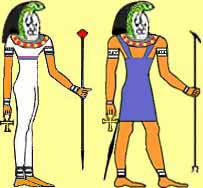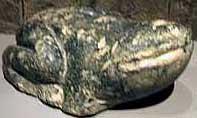

The Egyptians believed that before the world was formed, there was a watery mass of dark, directionless chaos. In this chaos lived the Ogdoad of Khmunu (Hermopolis), four frog gods and four snake goddesses of chaos.
These deities were Nun and Naunet (water), Amun and Amaunet (invisibility), Heh and Hauhet (infinity) and Kek and Kauket (darkness). The chaos existed without the light, and thus Kek and Kauket came to represent this darkness. They also symbolized obscurity, the kind of obscurity that went with darkness, and night.
The Ogdoad were the original great gods of Iunu (On, Heliopolis) where they were thought to have helped with creation, then died and retired to the land of the dead where they continued to make the Nile flow and the sun rise every day. Because of this aspect of the eight, Budge believe that Kek and Kauket were once deities linked to Khnum and Satet, to Hapi - Nile gods of Abu (Elephantine). He also believed that Kek may have also been linked to Sobek.

Kek (Kuk, Keku) means darkness. He was the god of the darkness of chaos, the darkness before time began. He was the god of obscurity, hidden in the darkness. The Egyptians saw the night time, the time without the light of the sun, as a reflection of this chaotic darkness.
- The Gods of the Egyptians, E. A. Wallis Budge
As a god of the night, Kek was also related to the day - he was called the "bringer-in of the light". This seems to mean that he was responsible for the time of night that came just before sunrise. The god of the hours before day dawned over the land of Egypt. This was the twilight which gave birth to the sun.
The feminine of the god Kek, Kauket (Keket) was a much more obscure goddess than her husband. She was a snake-headed woman who ruled over the darkness with her husband. Her name also meant darkness, as did her husband's name, but with a feminine ending.
- Coffin Text, Spell 76
Kauket was the feminine to Kek's masculine, more of a representation of duality than an actual goddess, so she was even less of a deity than Kek, and much more of an abstract.
She was, though, also related to the day - she was the "bringer-in of the night". This seems to show her to be the goddess of the night, just after sunset. The goddess of the the hours of the evening, as night covered Egypt, and the sun had disappeared. This was the twilight which turned into the darkness of night.